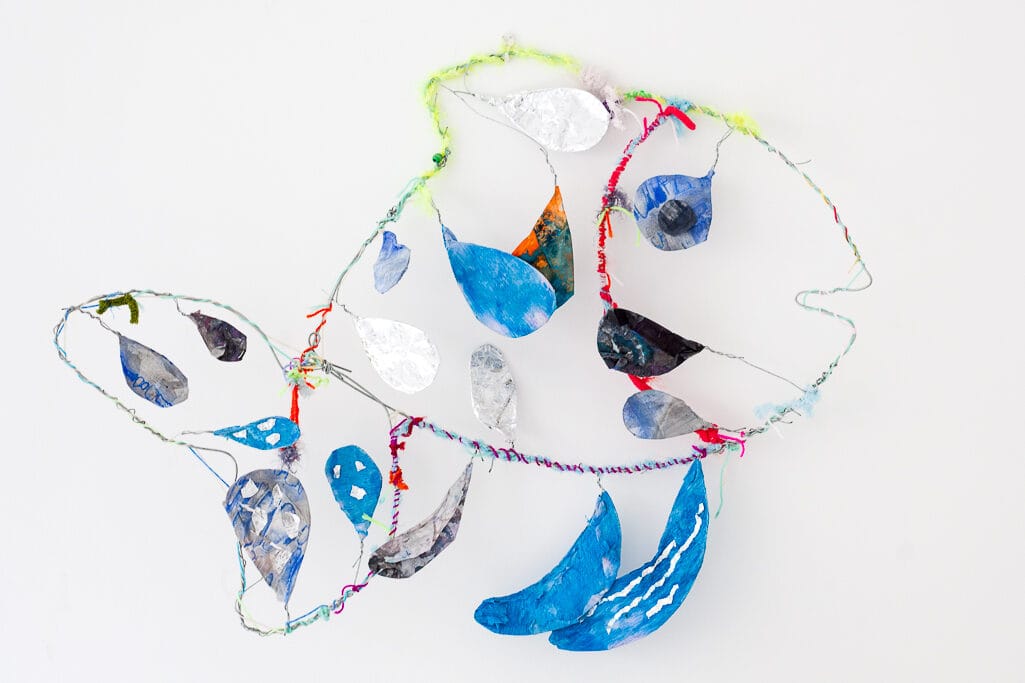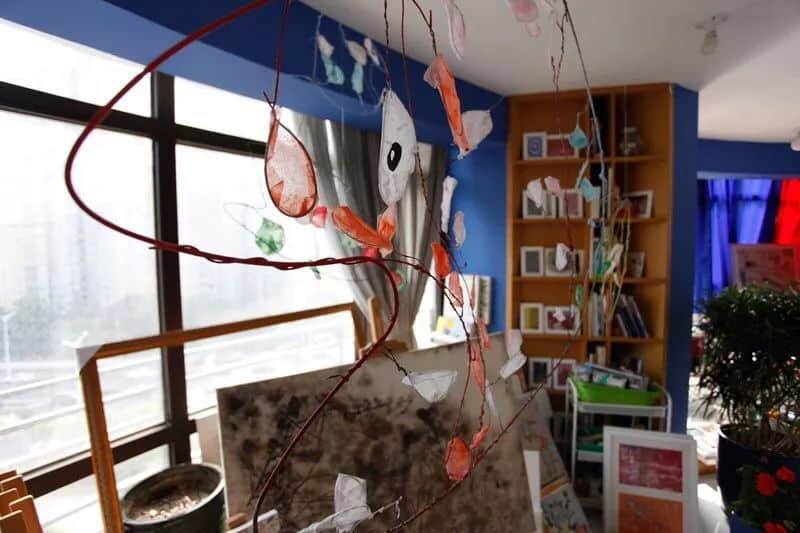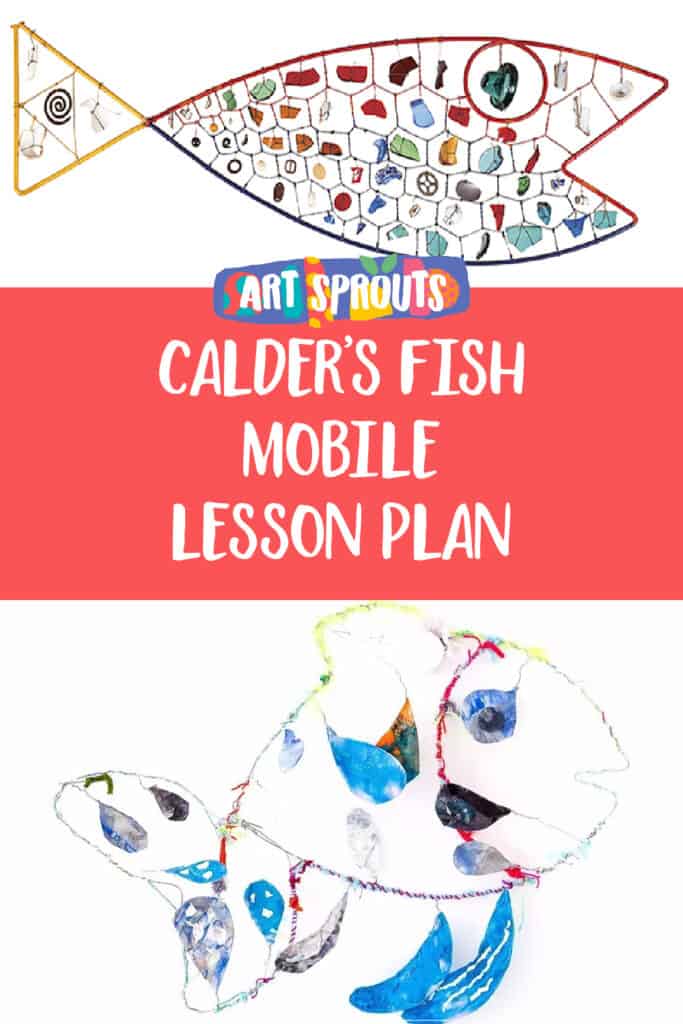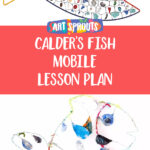This Calder fish mobile lesson has become a bit of a staple around here as there’s more to it than meets the eye. While we aren’t crafting a “true” mobile with every piece dancing around, this project is a great first step into some other big ideas.
Ever heard of kinetic art? This project gives kids a taste of it, providing a great opportunity to bridge the gap between art and science. It can also work as an introduction point to stories like the “Rainbow Fish” for those language arts moments. And if we’re talking big picture – it’s a fascinating sneak peek into how art has changed over time, touching on Modernism’s cool blend of art and tech. So, each time we dive into this Calder fish mobile lesson, we’re opening doors to loads of learning adventures.

Unleashing Creativity: Calder Fish Mobile Lesson
You may also be interested in:
- Play Like a Surrealist: 13 Surrealist Games and Techniques to Unleash Kids Creativity
- 21 Children’s Books About Famous Artists Kids Will Love

Curriculum Connections:
Art History, Visual Art, Modern Art Movements, Kinetic Sculpture
Background
Alexander Calder was not just any artist; he was an innovator, someone who always thought outside the box. Born in a family of artists in 1898 in Pennsylvania, art was in his blood.
However, before embracing art, Calder pursued mechanical engineering; it was precisely this combination of art and engineering that made his works stand out, as he viewed art from the lens of a mechanic and vice versa.

Imagine the joy of seeing art come to life, moving and swaying instead of just being still. That’s what Calder brought to the table with his invention of the ‘mobile.’ These curious sculptures weren’t just pieces of metal strung together; they were balanced perfectly, capturing the essence of life, movement, and playfulness.
Calder’s mobiles range from tiny pieces you could hold in your hand to gigantic installations that you could walk under.
What is Modernism?
The art world is vast, with artists over the years constantly trying to break boundaries and redefine the definition of art.
Modernism is one such significant movement that started in the late 1800s and flourished in the first half of the 20th Century.
During the modernist era, artists wanted to break free from the traditional shackles: new inventions, technologies, and the overall changing lifestyle influenced them. After all, if the world was evolving, why should art be left behind?

Paintings weren’t just portraits or landscapes anymore; sculptures weren’t mere imitations of reality. Art became abstract, symbolic, and sometimes even questioned the very nature of art itself.
Historical context
The times when Calder was creating his masterpieces were both thrilling and challenging. The world was witnessing a technological revolution. Imagine a world transitioning from horse carriages to cars, from letters to radios transmitting voices over vast distances. These advancements were reshaping everyday life.
But on the flip side, the world was also grappling with the shadows of World War I and World War II. Countries were in conflict, families were separated, and there was a general atmosphere of uncertainty. Amidst this chaos, art became a refuge.

It was a space for expressing hope, fears, dreams, and realities. For many, including Calder, art was not just a passion but a means of communication. Through his mobiles, Calder brought a sense of movement, suggesting that despite challenges, life moves on, always in a state of flux but also in balance.
DISCUSSION PROMPTS:
Younger Students: Focus on Calder’s playful nature, comparing his mobiles to toys, and explaining Modernism as artists “trying something new.”
Middle School Students: Delve deeper into Calder’s engineering background and how he combined that with art, making the connection between technological advancements (like cars and radios) and Modernism.
High School Students: Discuss the broader societal changes, technological advancements, and the impacts of World War I and World War II on the art community and the emergence of movements like Modernism. Highlight how artists like Calder sought to represent and respond to these shifts in their works.
What is a “mobile”?
A mobile sculpture is a type of kinetic art that consists of balanced, free-moving components often suspended in the air. The name “mobile” is derived from the French term “mobile,” which means “movable” or “capable of moving.” The term was coined by Marcel Duchamp, a French-American artist known for his influence on conceptual art and his association with the Dada movement. He came up with the term to describe the kinetic sculptures of his friend, American artist Alexander Calder.

These artworks can vary in size, from small, delicate pieces suitable for homes to monumental outdoor installations. The beauty of a mobile sculpture lies in its ability to move and change, usually driven by air currents or motors, creating a dynamic, ever-evolving visual experience.

Hands-on Activity
Materials:
- Metal wire
- Elmer’s glue
- Water
- Thin colored paper
- Container for mixing glue and water
- Strings (optional)
- Beads (optional)
- Old newspaper for easy cleanup
Step 1: Frame the fish
- Begin by bending the metal wire to create the outline of the fish. This will act as the main frame for your mobile. You can mold the eye or elaborate fins to give some character to each fish. Depending on the age and skill level of the students, a teacher’s assistance may be required to ensure the frame’s stability.
Step 2: Shape the scales
- Cut several pieces of metal wire, each about 20-30 cm long (approximately 8-12 inches).
- Twist one end of each wire piece to form a round shape, mimicking the fish’s scales.
- In a container, mix Elmer’s glue with water to create a diluted solution. The mixture should be of a consistency where it can coat the paper but isn’t too runny.
- Dip strips of colored paper into the glue mixture, ensuring they are well coated.
- Gently wrap the wet, glue-coated paper around the round end of the wire scales, molding them to take the form of a fish scale.
- Set them aside in a place where they can dry a bit. However, they don’t need to be completely dry for the fish to be assembled.

Step 3: Assemble your mobile sculpture
- Once the papier-mâché scales have dried a bit, wrap or twist the other end of each scale’s wire around the fish’s main frame. Make sure they are evenly spaced and cover the entirety of the fish frame.
- Find a balance point on your fish (usually near the head or midsection) and attach a longer piece of wire or string to it. This will be how your fish hangs and moves.
Step 4: Decorate (optional)
- For those wanting to add a touch more flair, twist strings and beads around the metal frame. These can dangle from the fish or wrap around the body, adding a decorative element to your mobile.
Tips:
- Ensure your working area is covered with newspapers or disposable table covers as papier-mâché can get messy.
- Hanging the fish in a well-ventilated area will help the papier-mâché dry faster.
- Encourage creativity! Allow students to experiment with different colors, shapes, and decorations.
By the end of this activity, each student should have a unique, Calder-inspired fish mobile ready to dance in the air!

Extensions:
Glossary:
- Mobile: A type of sculpture that has parts that move, often made of delicately balanced components that respond to air currents or motorized elements. Popularized by Alexander Calder, they can range from small tabletop pieces to grand outdoor installations.
- Kinetic Art: Artworks that involve movement or parts that move, often driven by natural forces like wind or light, motors, or interaction with viewers. The emphasis is on the motion and the process of movement rather than the final product.
- Modernism: An art and cultural movement that emerged in the late 19th and early 20th centuries. It represents a significant departure from traditional styles, embracing new forms of expression and often reflecting rapid changes in society, technology, and culture.
- Balance: In art, balance refers to the distribution of visual weight within a composition. Balance can be symmetrical, asymmetrical, or radial. In Calder’s mobiles, balance is both a visual and physical property, ensuring that the pieces remain in equilibrium.
- Movement: In the context of art, movement refers to the visual flow through the composition, leading the viewer’s eye from one element to another. Kinetic art, like Calder’s mobiles, brings in literal physical movement.
- Innovator: A person who introduces and applies new methods, ideas, or products.
- Abstract Art: A style of art that doesn’t try to represent accurate depictions of visual reality. Instead, it uses shapes, colors, forms, and gestures to achieve its effect, sometimes without a clear subject.
Cultural and historical connections
Bauhaus Movement: Originating in Germany, the Bauhaus was a revolutionary school of art, architecture, and design that greatly influenced Modernism. Their principles of form following function and the unity of art and technology echo in Calder’s works.

French Surrealism: Given the references to surrealist cultures in the lesson plan, diving deeper into the French surrealist movement can provide cultural insights. Artists like Salvador Dalí and René Magritte challenged reality in their works, a reflection of the broader societal shifts during the early 20th century.
Native American Dreamcatchers: Originating from Native American cultures, dreamcatchers were believed to give protection from negative dreams or spirits. Made using a web design and often adorned with feathers, they move with the wind, bearing some resemblance in function (protection) and form (movement) to mobiles.
Learn more on The Indigenous Foundation

Japanese Koinobori: Koinobori are carp-shaped windsocks traditionally flown in Japan to celebrate Tango no Sekku, a children’s day. They symbolize hope that children will grow up strong and resilient. Like Calder’s mobiles, these moving artworks play with wind and balance and can be used to discuss cultural symbols of growth, strength, and hope.

Inter-curricular connections:
Younger students:
- Science: Explore the basics of balance and gravity using Calder’s mobiles. How do they stay balanced? Why don’t they fall?
- Math: Counting and basic geometry can be incorporated by identifying shapes in Calder’s artworks.
- Physical Education: Incorporate balance-based activities or dances that require students to think about their center of gravity.
Older students:
- Science: Dive deeper into the physics of balance and movement. Discuss concepts like center of gravity and equilibrium using Calder’s mobiles as a reference.
- Math: Geometry can be further explored by analyzing the shapes and symmetries in Calder’s works. Students could also measure angles and estimate proportions.
- History: Study the technological advancements and global events of the early to mid-20th century. Discuss their impact on art and culture.
External resources:
The Calder Foundation – A treasure trove of information about Calder, his works, exhibitions, and other resources.
MoMA’s Collection on Modernism – The Museum of Modern Art’s website provides visual and informative content on Modernist artworks.
Save for Later:


